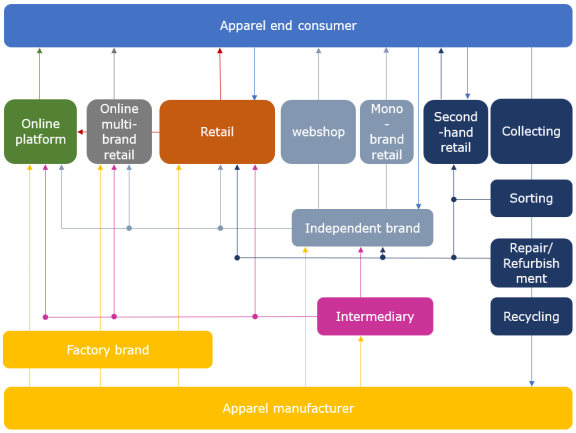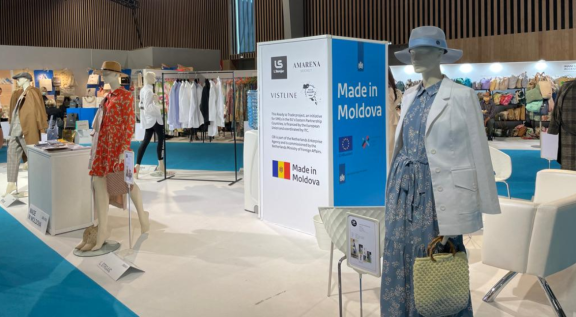
10 tips for finding buyers in the European apparel market
European buyers will only connect with you if you can offer something better or different than the suppliers they already have. This means you need to find buyers that match perfectly with your company and products. This report will help you understand where you can find interesting prospects and how to approach them.
Contents of this page
- Determine your unique selling points before approaching buyers
- Use AI to help develop a unique value proposition
- Search for buyers that match your size, MOQ, quality and price level
- Create a representative website and company profile
- Find potential buyers in online databases and on matchmaking websites
- Visit the right events and come prepared
- Follow up on new contacts immediately
- Find buyers via sector associations
- Let support organisations help you find buyers
- Set up a dedicated marketing and sales team
1. Determine your unique selling points before approaching buyers
Before approaching potential buyers, you need to determine your unique selling points (USPs). Ask yourself: What makes your company, your products, your service level or your CSR strategy special? What is your sales strategy? For instance, do you want to be the cheapest supplier in your country? Do you want to compete by being the most sustainable factory? By developing innovative materials and concepts? Or do you want to focus on a niche?
Successfully finding and engaging with new buyers is a continuous process. It takes large investments in time and money. If you do not prepare well by determining your own USPs, any match will likely fail.
Tips:
- Read our studies on buyer requirements and doing business with European buyers to learn what buyers require from a supplier and what extra services they appreciate;
- First research the potential export market and buyer before you spend time and money on connecting with the buyer. Check for instance Access2Markets for export trading information and the CBI study on demand in the European apparel market. Determine what type of buyer fits your company best and research their website, advertisement and products (style and design, quality level, price level).
Different buyers in the value chain
The most important distinction you should make between potential buyers is their place in the value chain because this will determine how they do business with you (see Table 1).
Within each part of the value chain, you will find buyers of different market sizes, with different requirements regarding quality, price, MOQs and sustainability. Each type of buyer needs a specific approach. Always try to find out in what part of the value chain your buyer is operating, what challenges they face in the market and how you can contribute to their company strategy.
Table 1: Different types of buyers in the European apparel market and their requirements
Who is your buyer? | Buyer-specific requirements | Examples |
|---|---|---|
| European end consumer | You can target European end consumers directly with your own online shop or social media channels, or indirectly via existing platforms. You will need to invest in an online shop, stock, order management and customer service. Your biggest challenges will be return policies and a lack of brand awareness. Online promotion and advertisement are key to success. Note that online B2C-platforms may require a percentage of each sale and/or a monthly fee. | Alibaba, Wish, Amazon, ASOS marketplace, Rakuten (Spain and France), Allegro (Poland), Bol (Netherlands, Belgium), Wolf & Badger |
| Online multi-brand platform | Online multi-brand platforms sell existing brands and often develop their own private collections, mostly value brands. They can detect market interest very quickly and will immediately react to sales data. Usually, these companies will place a small test order first. If the item is selling well, they will place the actual production order. Fast delivery is a must. | Zalando, Asos, Farfetch, Boozt (Scandinavia), About you, La Redoute (France), Yoox |
| Retailer | Apparel is sold by big retail chains in shops and online, and by smaller boutique shops that can be found in almost every European city. Retailers sell existing brands and may order collections specially developed and manufactured for them. Note that retailers have different ways of working. Zara, for instance, focuses on high flexibility, speed to market and production close to Europe. H&M is more focused on low price and high volume. | H&M, Inditex, Primark, Only, Jack&Jones, Next, M&S, C&A, Mango, KiK, Decathlon |
| Brand | Apparel brands typically develop a collection 6 to 9 months in advance. You will need a sample room, as brands require salesman samples (SMS) of each collection style. Every salesman sample needs to be actual: it must look exactly like the product will in the shop. It may take many months before orders are placed. | Petrol Industries, Adidas, Puma, Brunotti |
| Intermediary | Agents, traders, importers and private label companies sell your product on to buyers up the value chain. They are extremely price-focused and require flexibility in quantities and qualities. Some are located near or in the production countries and primarily do sourcing and logistics, others work from Europe and also do market research, design and stock keeping. | Li & Fung, Miles Group, Dewhirst, Broadway, Trademarktex, Fashionlinq |
Each type of buyer has a different sales channel (or combination of channels) they use to sell your product to the European end consumer, as shown below in Figure 1.
Figure 1: The apparel market value chain

2. Use AI to help develop a unique value proposition
AI tools like Mistral, Claude, ChatGPT and Deepseek can help you do market research and develop a unique proposition for your company. By using the right text prompts, these tools can analyse who your potential buyers are in any market, how best to engage with them, and who your main competitors are and why. You can ask AI tools things like:
- “Identify and list X potential leads for my business based on Y criteria in Z area.”
- “What makes our company stand out in the market?”
- “How can I best engage with X potential leads when my USPs are Y.”
- “Who are my main competitors in market X?”
This article on Bizway can help you write good text prompts to help you develop a winning value proposition.
3. Search for buyers that match your size, MOQ, quality and price level
Any type of buyer can be a good match if you can comply with their requirements. You need to study them, decide if you match and possibly develop your proposition if you want to have a chance of doing business. Always try to find out what challenges your potential buyer has and try to offer a solution. Be a problem-solver for them.
If you are a small to medium-sized manufacturer in a developing country, intermediaries are likely the most interesting type of buyer for you. They can give you the opportunity to learn about market requirements under the guidance of an experienced market player. Other interesting buyers could be small to medium-sized (niche) brands and retailers in the medium to high-price segment.
Bigger factories usually focus on larger orders for multi-brand online platforms and big value brands and retailers. Producing small, flexible orders is difficult in a large factory. Be aware that multi-brand online platforms and big value brands need full social and environmental compliance, which means you need all the relevant certifications. Big buyers mean big requirements.
End consumers are an interesting target group, because of increasing opportunities to reach them via online channels and potentially high profit margins. However, this market comes with complicated customer service demands (return policy, for instance). Starting a business-to-consumer company in Europe can only be successful if you have local distribution channels.
4. Create a representative website and company profile
Many manufacturers in developing countries, and in Europe for that matter, still think a website or online company profile has no priority. They are wrong. Being untraceable online is not only a missed promotional opportunity, it is also a first hint to potential buyers that you run an unprofessional organisation. Because building a professional website does not require large investments, this is an excellent opportunity to distinguish yourself from competitors.
What should you publish on your website? Advertise your USPs. Selling your company is even more important than selling your product, so focus on compliance, certifications, and your ways of contributing to sustainable and ethical production. Do not focus only on your products or the machines that you have: show your employees’ faces and make sure they smile in the pictures, to convey a positive image of your company.
Tips:
- Hire a specialised company or freelancer that can design and build a professional website for you. Ask for a design that can cross borders and cultures;
- Any website is as good as the content that is published on it. Hire a professional copywriter for the texts and a photographer for company and product photos. Otherwise use AI tools like Claude, ChatGPT or Deepseek. Focus on a design that reflects the brand’s identity and professional layout to convey trust;
- This article on Business News Daily provides tips on how to build an effective business website;
- If you do not want to spend a lot of money on a new website, YouTube offers tutorials on how to set up a simple but nice WordPress website for free. Note that a website requires maintenance. Designate an employee or freelancer to update content regularly;
- Create a company profile. This is a short version of your website showing your company’s USPs and sales strategy. Include your contact information for questions.
Promote your company online
Promoting your company online is one of the cheapest and most time-efficient ways of connecting to potential buyers. After you have created a representative website, it is important to direct potential buyers to it. There are several ways of doing this.
Social media
The most popular website for buyers in Europe to connect with other professionals is LinkedIn. If you do not have a profile yet, sign up and make one for free. Use the company profile that you created (see above) to make a LinkedIn company profile. Post articles or videos about new (product) developments in your company or directly approach potential buyers. Find apparel professionals by typing in ‘apparel’, ‘fashion’, ‘design’, ‘sourcing’ or related terms in the search bar.
You can also request to join specific sourcing groups, such as the Apparel Sourcing Group or Global Apparel and Textiles Sourcing.
Successful company webpages on LinkedIn include:
- Arvind (165,000 followers);
- Denim Expert (44,000 followers);
- Raymond Limited (230,000 followers).
These companies are not only successful because of their many followers on LinkedIn. Their opinion represents their industry and their vision helps others adapt to the changing industry. Their online publications and posts result in many interactions, making them seen and respected as industrial gamechangers.
Online search engines
Few buyers use online search engines to find new suppliers. To attract the buyers that do, make sure your website contains the term ‘manufacturer’ or ‘supplier’ plus the apparel items that you are specialised in and the country you operate in. Do a Google search for the keywords mentioned above and see which companies from your country are at the top of the search list. Try to analyse why the content on their websites makes them attractive for Google and draw inspiration for your own company website.
As there are many companies promoting their organisations online, the position of your website on Google determines the success of your website visibility. Make sure to invest in Search Engine Optimisation (SEO). Search Engine Land has an article on understanding the basics of SEO.
Paying for advertisement to promote your company
Before you decide to pay for advertisements (ads) on LinkedIn, Google or other online platforms, always compare your options and the different costs. Find out what results you can expect, set specific targets and start with small amounts of money. Websites like LinkedIn, Google and Facebook will let you target very specific groups based on very specific keywords, which is great. The problem with paid ads is that the cost per click (CPC) for the most effective ads can be substantial. That is because the most popular terms are the most expensive, because they attract the most competition.
Benchmarks for the CPC as well as click-through rates (CTR) can be found online, but ultimately it is for you to decide how much you want to invest in clicks. Check for instance these articles with benchmark information on CPC and CTR for:
Advertorials
An effective form of paid advertising is using advertorials to promote your business. Many popular online industry websites such as Fashion United or trade fairs such as Premiere Vision will publish paid articles on their website or in their newsletter. These articles can include photos of your company and products, or online videos, for example, about your company’s ambition or vision of the apparel manufacturing business.
Tips:
- Create an online profile on LinkedIn, YouTube, Twitter or Instagram and post articles, photographs and videos to draw attention to your company. Do not just publish uninteresting pictures of factory buildings. Remember that online viewers are interested in new developments in your products, company strategy, innovation, sustainability and people;
- Hire a professional copywriter, photographer or video editor to help create and publish engaging content. Use Upwork or Fiverr to find suitable marketing professionals;
- Hire an online marketing professional to do a ‘keyword research’ for you. This will generate ideas for articles and videos. Again, use Upwork or Fiverr and search for an SEO (search engine optimisation) specialist;
- Follow brands, retailers and people on social media you are interested in working with. This will provide you with company updates and news on their latest collections and travel schedules. They might also follow you in return;
- Approach popular international trade media in your market segment and ask for the possibilities of publishing advertorials;
- Create unique content that is not only focussed on promoting your company but also on sharing your ideals and vision on the industry and global environmental developments. This can be done, for instance, on a blog page;
- Create a newsletter to inform your buyers and the sector of your latest developments.
5. Find potential buyers in online databases and on matchmaking websites
Several websites will let you search for potential buyers in a database of companies. Finding the name of a retailer or brand is not the biggest challenge, however. Connecting to the right sourcing manager in that company is. A great way to do this is to search on LinkedIn for sourcing managers at the companies that you have discovered in an online database. Other websites are specifically built to connect supply and demand in the apparel industry.
- Fashion United offers a database of European apparel brands and retailers by size and value.
The following websites are among the most-used matchmaking platforms by European buyers. Here you can sign up and connect with buyers that publish requests for quotations. All websites let you sign up for free. Some also have a paid membership service. In addition to promoting your offers, these websites let you browse inquiries from buyers as well. Be aware that the EU is reconsidering abolishing import duty advantages for entering the EU on goods below €150, commonly sold by online marketplaces like Temu and Shein. The EU considers these products a risk to the environment, consumers’ health and safety as many products are non-compliant, and the competitiveness of EU businesses.
- Alibaba – The world’s largest online B2B marketplace and one of the most popular platforms in Europe. It lets buyers search for suppliers of many different products, not only apparel, by country, product category, MOQ, total revenue and certifications. Alibaba supports many different languages besides English;
- Apparel Buyer Contact – Not a matchmaking platform but a consultancy service, selling comprehensive lists of European apparel buyers: the actual people responsible for sourcing apparel within European apparel companies, with their contact data;
- Fibre2Fashion Marketplace - Fibre2Fashion is one of the oldest and biggest online B2B portals specifically for the apparel industry. Next to matchmaking services for products ranging from fibres and fabrics to accessories and machinery, it offers analysis reports, consultancy services and a magazine;
- Foursource – Together with Alibaba, Foursource is the most-used platform in Europe, specifically for apparel sourcing. Foursource lets buyers search for suppliers by country, product category, MOQ and certifications. It also offers manufacturers the opportunity to present their products in a virtual showroom;
- Indiamart – Considered the world’s second-largest online B2B marketplace after Alibaba, specifically built for suppliers from India;
- Sewport – An online B2B matchmaking platform to help designers and emerging brands find apparel manufacturers that can handle small to medium-sized MOQs. Sewport allows buyers to upload their sketches, tech packs and order quantities.
Tips:
- Always fill out all the required fields in your company profile on an online matchmaking platform. At the very least, mention the products you are specialised in, your target group, segment (active, casual, formal wear), product categories (such as top wear, knit wear, skirts, suits), the average MOQ and any management or CSR certificates you may hold;
- Invest in good product photography. Check, for example, how Zalando does this. Apparel items should always be photographed in the same manner. Highlight product details such as fabric and design; include multiple angles and zoom options;
- If the platform offers the possibility of writing an elaborate company profile, mention your company’s history, USPs, certifications and growth strategy;
- To attract international clients, offer your website in multiple languages, including English and the languages spoken in the markets you are targeting. If writing in English or another target language is difficult for you, hire a translator to fill out your company profile for you; otherwise, use Google Translate or AI translation tools like Claude, ChatGPT or Deepseek;
- Regularly check the buyer inquiries on your matchmaking platform to discover what buyers are looking for and what their requirements are. If possible, activate automatic notifications for inquiries that match your offer.
Other interesting databases are the member lists of organisations concerned with sustainable production. The list below contains most of the biggest and best-known initiatives in the textile and garment industry. Another option is to check the member lists of sustainability standards. The ITC Standards map offers an extensive overview. Clicking on the logo in the table below will take you to the members list of the organisation.
Table 2: Sustainable textile industry organisations and their members

| 
| 
| |

| 
| 
|
6. Visit the right events and come prepared
Trade fairs used to be the most important events for buyers and suppliers to meet and do business. They are not that important anymore, as many buyers and suppliers have found other, more time- and cost-effective ways to connect, for instance online. However, physical trade fairs can still be an interesting way to find potential buyers, if you prepare properly.
The following trade shows offer the best opportunities for connecting with European buyers. Every fair has a specific target group.
Figure 2: Participate in local support initiatives such as a national pavilion at a trade fair.

Source: FT Journalistiek
Fibres
- Pitti Filati: fibre and yarn fair in Florence, Italy.
Fabrics
- Première Vision: Europe’s most important international fair for yarns, fabrics, accessories, leather and trends in Paris;
- Texworld: fair for fabrics, trims and accessories, held simultaneously with Premiere Vision in Paris;
- Munich Fabric Start: fair for fabrics, accessories and innovations in Munich;
- Intertextile: fair for fabrics and accessories in Shanghai.
Leather
- Lineapelle: fair for leather, synthetics and accessories in Milan;
- ILM: leather goods fair in Offenbach, Germany;
- Gallery: shoes in Düsseldorf, Germany;
- ACLE: fair for leather, footwear and accessories in Shanghai;
- APLF: fair for leather goods, accessories and fabrics in Hong Kong.
Apparel manufacturing
- Apparel Sourcing in Paris, France: the biggest garment sourcing fair in Europe, with nearly 30,000 visitors;
- Who’s Next in Paris, France: attracts mostly small and medium-sized brands;
- Source London: a combination of brands and private label manufacturing, heavy focus on sustainability;
- Interfilière in Paris, France: fair for lingerie and swimwear;
- ISPO in Germany: fair for sportswear;
- A&A in Düsseldorf, Germany: fair for workwear;
- AFSW in Ethiopia: biggest apparel sourcing fair in Africa.
Remember that participating in a trade fair can be a costly business. You need to hire a booth, prepare a collection, pay for transport, travel costs and working hours for yourself and your staff. To avoid disappointments and lost investments, always come prepared.
Tips:
- For a comprehensive overview of online and offline fashion trade shows and fairs, visit Fibre2Fashion or FashionUnited;
- Research the target group before you participate in a trade fair. Check the fair’s visitor numbers and main market segments. This will help you decide which event you want to attend;
- Try to participate in trade fairs and online events that offer one-on-one matchmaking sessions with buyers. Also create a list of potential buyers and inform them about your participation. Invite them to your booth. Do the same for current buyers;
- Talk to other fair participants about market trends as well as potential new markets and buyers. A trade fair is the easiest way to talk to many potential business partners quickly;
- If you attend a physical fair, advertise your USPs clearly in your booth. Do you offer low MOQs? Super short lead times? Specific certifications? Put that on a sign and show it to visitors;
- If you attend a physical fair, try sharing a booth with another company (from your country) to lower costs or connect with an export coaching programme, such as CBI;
- Develop a new collection that includes both samples and fabrics. Collect special fabrics from your different fabric suppliers. Do not use basic qualities. Collect different production samples and focus on special styles that will attract buyers, while also displaying your technical skills.
7. Follow up on new contacts immediately
Your work as an exhibitor at a trade fair, online trade show or matchmaking event does not end when the event is over. It has only just begun. Be quick to reconnect with potential buyers you have met. Send them promotional materials, samples or answers that they have asked for.
Tips:
- After sending all the requested information and materials, do not wait for a reply but plan an online meeting, or a visit to the buyer’s office. In the meantime, your prospective buyer can use your information to prepare inquiries, developments and orders;
- Read our study ‘Doing Business with European Buyers’ to learn how to effectively follow up on new contacts;
- Invest in a reliable Wi-Fi connection and the right software so you can talk to potential buyers online. Many popular online conferencing programmes like Google Meet, Microsoft Teams and Zoom are free to download;
- For quick follow-ups via text or video, use WhatsApp, Signal or FaceTime (this works best if you both use iPhones).
Figure 3: If you get questions via email, always confirm within a day, even if it is just to announce that you will respond more elaborately later.

Source: Photo by Brett Jordan on Unsplash
8. Find buyers via sector associations
Sector associations in the apparel industry represent and support member companies. In many cases, this includes providing information on sourcing issues, so this means opportunity for you to connect with potential buyers. Select a sector association for the companies you want to target and ask the association for possibilities to publish an introduction in their newsletter, or to participate in a matchmaking event. Most associations publish a list of members online, which is an easy way to gather data on potential buyers.
The following sector associations are the most important in Europe. They represent different international and national markets and market segments.
- The International Apparel Federation represents sector associations, brands and manufacturers in more than 40 countries;
- The European Branded Clothing Alliance represents over 70 member companies;
- Eurocommerce represents the interests of big retailers, wholesalers and retail federations in Europe.
European sector associations:
- German fashion represents the German fashion industry and the interests of its 350 member companies;
- The Fashion Council Germany is another German association, supporting more than 100 German fashion brands and retailers;
- The FHCM is the French sector association for high-end apparel brands;
- The UK Fashion and Textile association represents more than 400 fashion brands and designers in the UK;
- Mode Suisse represents the interests of companies in the Swiss textile industry and retail market;
- The Association of Swedish Fashion Brands represents the interests of 70 Swedish fashion brands;
- Modint is the sector association for Dutch apparel companies focusing on wholesale and manufacturing.
For an overview of national sector associations, check the member page of Euratex, the European confederation of textile and apparel associations.
The following are sector associations for specific apparel markets or niches:
- PCIAW is the international sector association for workwear;
- COTANCE is the representative body of the European leather industry;
- Children’s Fashion Europe promotes the interests of children’s fashion companies in Europe. It is formed by several national children’s fashion associations.
United Fashion is an independent platform connecting manufacturers to independent European designers and start-up fashion labels.
Tips:
- Contact the sector associations in your target market or market segment and ask about different service models for matchmaking;
- Most associations send out monthly newsletters with relevant industry updates. Sign up for these publications to stay up to date with developments in the industry;
- Search for sector associations that cater to your needs by searching online for your niche, using terms like ‘industry group’, ‘federation’, ‘platform’ or ‘institute’;
- A good listing with sector and industry associations in your home country can also be very useful in connecting with European buyers. Buyers may attend a(n online) sourcing mission to your country and one of their first steps will be to contact the sector and industry bodies in your country.
9. Let support organisations help you find buyers
Several international support organisations support the apparel industry in developing countries with export coaching. These organisations are funded by different governments and deploy sector experts. Participating in developing programmes is a good way to develop your business potential in the European market.
Tips:
- In addition to market intelligence reports, CBI offers export coaching, including marketing advice and matchmaking to SMEs in 35 countries. Check CBI’s website for an overview of current apparel programmes;
- Other organisations that regularly offer coaching programmes for apparel exporters in developing economies are the UNDP, FCDO, DANIDA, ITC, GIZ, SIPPO, ICCO and Solidaridad;
- PUM is a Dutch NGO that offers practical support by senior apparel industry experts on anything from business process management to arranging your exports;
- Investigate if your country has a support organisation for exporting apparel to Europe, such as India’s AEPC, Egypt’s ETDA, Ethiopia’s ETIDI or Tunisia’s FTTH. Also check your local chamber of commerce. Buyers interested in sourcing apparel from your country will approach them for factory information;
- Connect with different NGOs active in your country and ask if you can join an export coaching programme.
10. Set up a dedicated marketing and sales team
In many factories in developing countries, marketing and sales is done by one person: the CEO. This should be avoided. Developing and executing a successful marketing and sales strategy is too much work for one person. Secondly, marketing and sales require expertise and experience. Marketing is promoting your organisation. Sales has a clear focus on business development and buyer relationship. Both disciplines are highly specialised.
Tips:
- Create a clear marketing strategy that is in line with the company strategy and that supports your sales targets;
- Don’t think you can represent and promote the company on your own if you also have other managerial tasks in your company. Marketing and sales is a continuous effort. You will most likely lack the time to do everything by yourself;
- Hire a specialist to help develop and execute both your marketing strategy and your sales strategy. As online marketing is becoming more important, search for a specialist with expertise in online marketing;
- Marketing can be outsourced to a marketing agency, but always discuss and define clear targets to make sure your expectations will be met.
Hire a sales agent or representative
Developing and maintaining relationships with new buyers is a continuous, long-term process. A good way to do this is to employ a local sales agent or representative. The trend is that more and more manufacturers invest in sales offices and showrooms in Europe and employ representatives. Do not think, however, that anybody with a large network in Europe will get you easy orders. Prepare for a long-term investment in sales.
Figure 4: Because sales is a long-term process, having a local representative can make it easier for you to find (new) buyers.

Source: Photo by LinkedIn Sales Solutions on Unsplash
Tips:
- Find sales agents or representatives on LinkedIn. Search for ‘sales’ plus the term ‘apparel’, ‘fashion’ or the particular apparel item that you want to export. Try to find a sales representative for each country you want to export to, because most sales agents have a network limited to one country;
- Another good way to find a sales agent is to approach a European headhunting company and ask them to connect you to any apparel sales agent that has recently retired. These people often have a large network, and plenty of spare time. With a compelling story, you might get them to work with you. Dutch NGO PUM is another good source for finding senior apparel industry experts with a large network that can help you;
- In case you consider setting up a local office or showroom or employing a sales agent, but the costs are too high, try creating a collective with other exporters so you can share the expenses;
- Train your sales agents in both manufacturing and cost calculation. This will make it easier for them to negotiate successful business deals. The CBI report on cost calculation offers a comprehensive guide on how to calculate the cost price of any apparel item;
- Define clear and realistic sales targets that you can measure and guide.
Use your existing network to find new buyers
If you have a good personal relationship with a buyer at a company, sharing your ambitions can open new doors. Buyers often have a large local network in the industry and will usually be happy to refer you to a friend if they are satisfied with the business relationship.
When a buyer moves from one employer to another, stay connected via LinkedIn. This will help you follow up on any career changes your contact might make and will let you see your buyer’s network.
Keep relations with current buyers strong and grow your business
Finding new buyers and setting up a business relationship is one the hardest things to achieve in the apparel industry. It is therefore important to keep the buyers you have and expand your business with them. If your buyer is happy, they will advocate for you within and hopefully also outside the company.
Remember the three phases of doing business successfully with a European apparel buyer:
- Phase 1: You have found a buyer and gotten a first order based on your unique offer, products, service level and compliancy. You have potentially solved a problem that the buyer has;
- Phase 2: Now is the time to build trust and keep your business going, based on your high level of service (on-time delivery, impeccable quality and smooth communication);
- Phase 3: If your buyer is consistently happy with you, there is a good chance of growing your business by getting more orders, higher volumes, a better price or different orders (other services including design and fabrics).
Further reading
The CBI study ‘11 tips for doing business with European buyers’ will help you understand what is needed to successfully approach a potential buyer and how you can develop a long-lasting business relationship with them.
The CBI study ‘10 tips for organising your exports’ will give you quick answers to the most pressing issues that come into play when organising shipments to Europe.
FT Journalistiek carried out this study in partnership with Giovanni Beatrice on behalf of CBI.
Please review our market information disclaimer.
Search
Enter search terms to find market research
